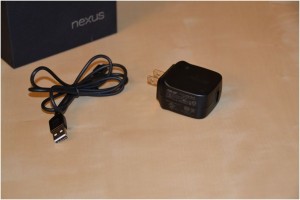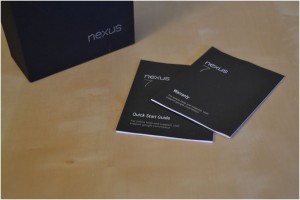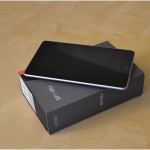 After Google’s foray into the consumer hardware space in 2008 with the G1, Android products have improved drastically. In 2012, it made sense to join the tablet scene, and in July, Google introduced the Nexus 7.
After Google’s foray into the consumer hardware space in 2008 with the G1, Android products have improved drastically. In 2012, it made sense to join the tablet scene, and in July, Google introduced the Nexus 7.
This followed with the announcement of the 32 GB Nexus 7 in November and, with a price decrease for the 16 GB model to $199, they hit the sweet spot for tablet pricing. Priced the same as the Amazon Kindle Fire HD, and $30 cheaper than the Barnes & Nobel Nook HD in a similar 16 GB configuration, things now to seem no more than a personal preference.
Aside from the storage capacity change in the Nexus 7, nothing else has changed from its original iteration. This is perfectly acceptable as the tablet has benefited from quality components right from the beginning.
SPECIFICATIONS
Google and Asus did a great job in creating the Nexus 7. Measuring in at 7.81″x4.72″, they managed to have the lowest surface area between the Kindle Fire HD and Nook HD. Its weight is also only 12 oz, about the same as most tablets of the same size.
The Google Nexus 7 is powered by a Nvidia Tegra 3 quad-core processor running at 1.3GHz and 1GB of RAM. This is the same processor powering both the Xperia Tablet S and the Asus Transformer Pad TF300T. This device comes packed with GPS, NFC, Bluetooth and a few sensors under the hood including an accelerometer, magnetometer and gyroscope. The GPS is definitely an interesting addition to a Wi-Fi only tablet as you could even use it as a car navigation device. Google claims the battery will give you 300 hours on standby, 10 hour of web browsing and 9 hours of HD video playback. We found these numbers to be on the money, having the tablet easily stretch a weekend with on and off use. If you want to increase battery life, turn off the GPS to gain a noticeable difference.
PACKAGING AND EXTERIOR
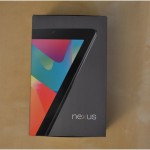 A quick look at the exterior packaging face does not identify the model storage so be sure to look at the sticker on the bottom prior to purchase. Our review sample is 16GB with Wi-Fi and multiple configurations are available. Wi-Fi only models come in 16 GB and 32 GB and the mobile data model for AT&T or T-Mobile comes in only a 32 GB form factor.
A quick look at the exterior packaging face does not identify the model storage so be sure to look at the sticker on the bottom prior to purchase. Our review sample is 16GB with Wi-Fi and multiple configurations are available. Wi-Fi only models come in 16 GB and 32 GB and the mobile data model for AT&T or T-Mobile comes in only a 32 GB form factor.
The mobile data connected Nexus 7 is a great addition to the lineup as finding a Wi-fi hotspot is not always convenient.
Sliding open the Nexus 7 packaging for the first time, you ‘re greeted with your new tablet right off. A USB Charger with a detachable micro-USB cable for either wall charging or through your computer is the only accessory included with the Nexus 7, to include a quick start guide and warranty note.
Turning on the tablet for the first time, the quality of the 1280×800 LED backlit screen with 216ppi hits you right off. While running through the setup, we found the text to be crisp and clear with effective viewing at just about any angle. Indoors we had no issue reading in any light conditions, however when outside, its glossy screen was not the best in direct sunlight. Between the 7 inch tablets compared, only the Nook HD had a better screen with a 1440×900 resolution and 243ppi.
As manufacturing partner to Google, Asus built a quality product with a simple and elegant design. A metal bezel joins a Gorilla Glass front panel to a textured hard rubber backing for a nice solid grip. There are no buttons on the front giving it a sleek look, opting to put volume and power on the back right corner where it blends in with the hard rubber. The micro-USB and headphone jack are also placed on the bottom with the words Nexus and Asus displayed along with a speaker for great sound.
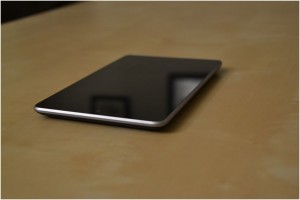
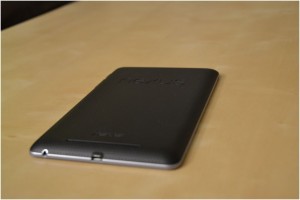 The speaker has much more treble than bass and, aside from listening your tablet speaker at full volume, it does a good job of not distorting vocals. The volume, on the other hand, is plenty loud and can easily be heard over a few people talking. If you choose to seek a case for your Nexus 7, make sure there is a large opening for the speaker as anything over part of the speaker considerably deteriorates the quality of sound.
The speaker has much more treble than bass and, aside from listening your tablet speaker at full volume, it does a good job of not distorting vocals. The volume, on the other hand, is plenty loud and can easily be heard over a few people talking. If you choose to seek a case for your Nexus 7, make sure there is a large opening for the speaker as anything over part of the speaker considerably deteriorates the quality of sound.
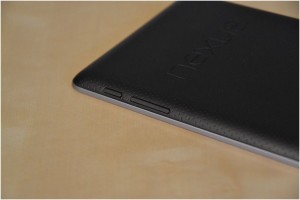
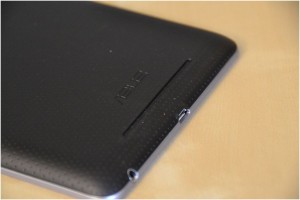 As we can see, there is no camera on the back, however there is a front facing 1.2 megapixel camera that serves its purpose for Google Chat and Skype use.
As we can see, there is no camera on the back, however there is a front facing 1.2 megapixel camera that serves its purpose for Google Chat and Skype use.
 Technology X Tomorrow's Technology Today!
Technology X Tomorrow's Technology Today!

